Question:
A particle of mass m is moving in the potential
\[ V(x) = \begin{cases} V_0 + \frac{1}{2} m \omega_{0P}^2 x^2 & \quad \text{if } x > 0 \\\infty & \quad \text{if } x \leq 0 \end{cases}\]
Figures P, Q, R, and S show different combinations of the values of \( \omega_0 \) and \( V_0 \).
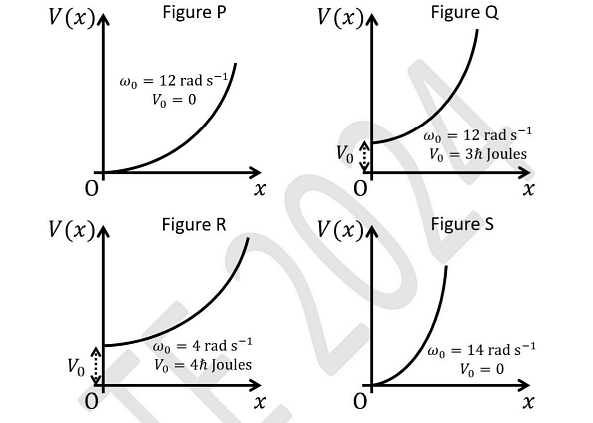
Let \( E^{(P)}_j \), \( E^{(Q)}_j \), \( E^{(R)}_j \), and \( E^{(S)}_j \) with \( j = 0, 1, 2, \ldots \), be the eigen-energies of the j-th level for the potentials shown in Figures P, Q, R, and S, respectively. Which of the following statements is/are true?
A particle of mass m is moving in the potential
\[ V(x) = \begin{cases} V_0 + \frac{1}{2} m \omega_{0P}^2 x^2 & \quad \text{if } x > 0 \\\infty & \quad \text{if } x \leq 0 \end{cases}\]
Figures P, Q, R, and S show different combinations of the values of \( \omega_0 \) and \( V_0 \).

Let \( E^{(P)}_j \), \( E^{(Q)}_j \), \( E^{(R)}_j \), and \( E^{(S)}_j \) with \( j = 0, 1, 2, \ldots \), be the eigen-energies of the j-th level for the potentials shown in Figures P, Q, R, and S, respectively. Which of the following statements is/are true?
\[ V(x) = \begin{cases} V_0 + \frac{1}{2} m \omega_{0P}^2 x^2 & \quad \text{if } x > 0 \\\infty & \quad \text{if } x \leq 0 \end{cases}\]
Figures P, Q, R, and S show different combinations of the values of \( \omega_0 \) and \( V_0 \).

Let \( E^{(P)}_j \), \( E^{(Q)}_j \), \( E^{(R)}_j \), and \( E^{(S)}_j \) with \( j = 0, 1, 2, \ldots \), be the eigen-energies of the j-th level for the potentials shown in Figures P, Q, R, and S, respectively. Which of the following statements is/are true?
Updated On: Sep 4, 2024
- \( E^{(P)}_0 = E^{(Q)}_0 \)
- \( E^{(Q)}_0 = E^{(S)}_0 \)
- \( E^{(P)}_0 = E^{(R)}_0 \)
- \( E^{(R)}_0 \neq E^{(Q)}_0 \)
Hide Solution
Verified By Collegedunia
The Correct Option is B, C, D
Solution and Explanation
The correct Answers are (B):\( E^{(Q)}_0 = E^{(S)}_0 \),(C):\( E^{(P)}_0 = E^{(R)}_0 \),(D):\( E^{(R)}_0 \neq E^{(Q)}_0 \)
Was this answer helpful?
0
1
Top Questions on Magnetism and matter
- The temperature \( T \) dependence of magnetic susceptibility \( \chi \) (Column I) of certain magnetic materials (Column II) are given below. Which of the following options is/are correct?
Column I Column II (1) 
(P) Diamagnetic (2) 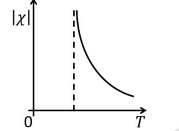
(Q) Paramagnetic (3) 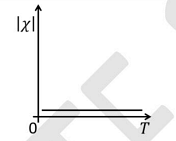
(R) Ferromagnetic (4) 
(S) Antiferromagnetic - GATE PH - 2024
- Physics
- Magnetism and matter
- A material behaves as a superconductor below a critical temperature \( T_c \) and as a normal conductor above \( T_c \). A magnetic field \(\overrightarrow{B} = B\hat{z}\) is applied when \( T > T_c \). The material is then cooled below \( T_c \) in the presence of \( \vec{B} \). Which of the following figures represents the correct configuration of magnetic field lines?
- GATE PH - 2024
- Physics
- Magnetism and matter
- An infinite one-dimensional lattice extends along the x-axis. At each lattice site, there exists an ion with spin 1/2. The spin can point either in the +z or -z direction only. Let \( S_P \), \( S_F \), and \( S_A \) denote the entropies of paramagnetic, ferromagnetic, and antiferromagnetic configurations, respectively. Which of the following relations is/are true?
- GATE PH - 2024
- Physics
- Magnetism and matter
A proton is projected with speed v in magnetic field B of magnitude 1 T. The angle between velocity and magnetic field is 600 as shown below. The kinetic energy of a proton is 2 eV (mass of proton = \(1.67\times10^{-27} kg\), e = \(1.6\times10^{-19}\)C). The pitch of the path of the proton is approximately?
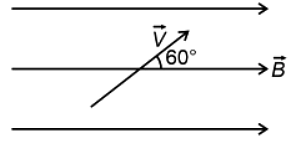
- JEE Main - 2023
- Physics
- Magnetism and matter
- The Curie temperatures of Cobalt and iron are 1400K and 1000K respectively. At T = 1600K , the ratio of magnetic susceptibility of Cobalt to that of iron is
- KCET - 2023
- Physics
- Magnetism and matter
View More Questions
Questions Asked in GATE PH exam
- Consider the Lagrangian \( L = m\dot{x}\dot{y} - mw_0^2 zxy \). If \( p_x \) and \( p_y \) denote the generalized momenta conjugate to \( x \) and \( y \), respectively, then the canonical equations of motion are _______.
- GATE PH - 2024
- Motional EMF
- If \( F_1(Q, q) = Qq \) is the generating function of a canonical transformation from \((p, q)\) to \((P, Q)\), then which one of the following relations is correct?
- GATE PH - 2024
- Functions
- An extrinsic semiconductor shown in the figure carries a current of 2 mA along its length parallel to the \( +x \) axis.
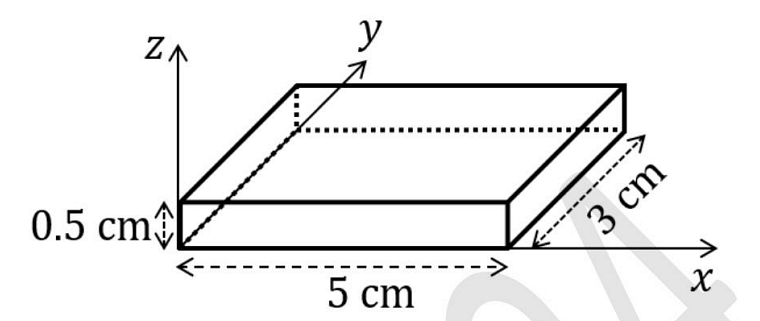
When the majority charge carrier concentration is \( 12.5 \times 10^{13} \, \text{cm}^{-3} \) and the sample is exposed to a constant magnetic field applied along the \( +z \) direction, a Hall voltage of 20 mV is measured with the negative polarity at the \( y = 0 \) plane. Take the electric charge as \( 1.6 \times 10^{-19} \) C. The concentration of minority charge carriers is negligible. Which of the following statements is/are true?- GATE PH - 2024
- Semiconductor
- Binding energy and rest mass energy of a two-nucleon bound state are denoted by \( B \) and \( mc^2 \), respectively, where \( c \) is the speed of light. The minimum energy of a photon required to dissociate the bound state is _______.
- A particle of mass \( m \) in an infinite potential well of width \( a \) is subjected to a perturbation \( V' = \frac{h^2}{40ma^2} \) as shown in the figure, where \( h \) is Planck's constant.

The first-order energy shift of the fourth energy eigenstate due to this perturbation is \( \frac{h^2}{Nma^2} \). The value of \( N \) is ____ (in integer).- GATE PH - 2024
- Electric Charge
View More Questions



